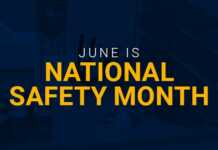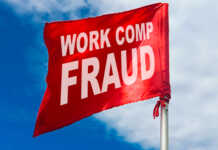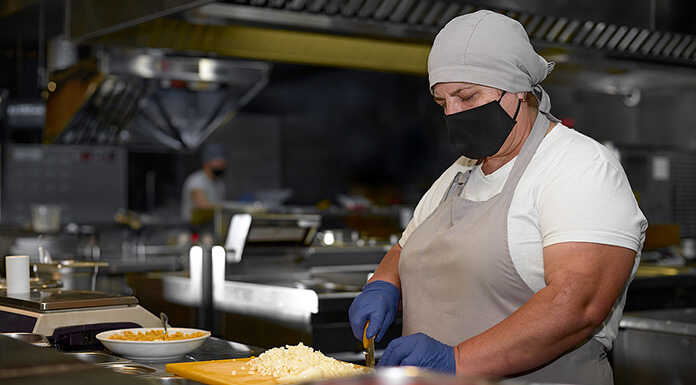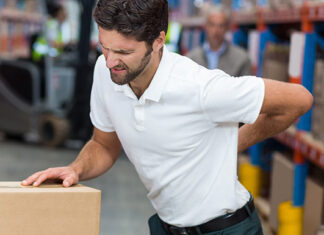As more foodservice facilities open up during COVID-19 to accommodate larger capacities, it’s a good time to evaluate your safety program. Preventing injuries in the foodservice industry can save lives, time, and money by reducing the cost of workers’ compensation claims, maintaining productivity, and increasing employee morale. Many employers understand the value of a written safety program and ongoing communication of safe practices.
To take your safety program a step further, solutions to identify and remove hazards need to be continuously addressed. Employees should be empowered to develop skills in hazard recognition and be rewarded for providing feedback in making their work environment a safer place.
Identify Common Types of Injuries
Cuts, strains, and slip/fall injuries are the most common types of injuries reported in the foodservice industry. It is important to understand where the injuries are typically coming from to prevent them from occurring.
Cuts and laceration injuries can result from various tasks, including the use of knives for food preparation, handling of dishes and glassware, opening boxes and packages, and cleaning equipment or surfaces with sharp edges.
Considerations to prevent cuts and laceration injuries include:
- Communicate proper knife handling. When handling blades and knives, cut away from your body.
- Keep knives and blades sharp, as this improves accuracy and decreases fatigue. Store knives in protective cases and all sharp items in a designated storage area. Utilize boxcutters with retractable blades.
- Appropriate gloves should be worn for cutting or cleaning tasks, and they should fit properly.
- Consider removing knife handling exposures by using pre-cut produce and ingredients.
- Ensure appliances are equipped with machine guards.
- Store glasses and dishware in racks, and away from areas with high levels of foot traffic.
Heavy lifting and awkward postures can lead to strain and sprain injuries. Employees may need to lift boxes of ingredients, soda syrups, ice buckets, commercial mixer bowls, trays and bins of dishware, and containers for oil filtration and trash removal.
To minimize manual handling and awkward postures:
- Provide hand trucks, wheeled carts, commercial mixer bowl dollies, mobile lifters, and other devices to reduce the need for manual handling.
- Utilize smaller trays, bus containers, and ice buckets.
- Request that the vendor deliveries be placed into the designated storage areas, such as directly on the racks of the coolers and freezers.
- Provide ladders and footstools to prevent awkward reaching postures.
- Place heavier items in the middle of the racks at heights between the chest and knees.
Slips and fall injuries are especially prevalent in the foodservice industry. Kitchens can be cluttered and have obstructed work areas. Floors have the potential to be covered in debris and various types of spills involving water, oil, and food.
Remove the hazards that commonly lead to slip and fall injuries:
- Wipe up any spills, organize the storage of supplies and ingredients, pick up food debris and trash, clear electrical cords, and keep walkways clear.
- Wear appropriate footwear with non-skid soles. Ensure shoes are inspected regularly to ensure their effectiveness.
- Mats should not be allowed to bunch up or fold – they should have their edges tapered or fastened down securely.
- Wipe down any condensation that builds up in the walk-in freezers, as this could lead to slippery walking surfaces.
- Implement a two-step mopping process: in the first step, apply the cleaning solution and ensure it is given enough time to break down contaminants. Then, use a clean and wrung-out mop to soak up the solution.
- Use the appropriate cleaning solutions for the various types of contaminants, such as grease, dirt, or bacteria.
Communicate the Importance of Reporting Hazards, Incidents, and Injuries
Injuries, “near miss” incidents, and hazards need to be reported right away. A “near miss” is an incident or unplanned event that did not result in injury, illness, or damage – but had the potential to do so. Prompt reporting of these items helps to promote a safe workplace, as it can prevent future injuries from occurring.
Remind employees to take the following actions on reporting hazards, incidents, and injuries:
- Ask for help if an injury occurs and report it even if it seems minor.
- Eliminate the potential hazard if possible.
- Report a potential hazard to a supervisor or maintenance member. A procedural change or more in-depth repair may be needed to prevent the hazard from reoccurring.
- Share ideas on safe practices that could be implemented for workplace improvements.
- Keep an eye on one another and encourage each other to be safe.
Recognize Employees through Behavior-Based Safety Incentives
Engaging employees is crucial in establishing a workplace safety culture. It is far more effective to have all employees involved in hazard recognition and injury prevention than to assign this responsibility solely to your managers and supervisors. Recognition and positive reinforcement of safe behaviors can increase morale, reduce the frequency of injuries, and lower claims costs. Employees can be recognized and rewarded for:
- Participating in safety meetings by leading the meeting, sharing a personal experience, or providing a demonstration related to the safety topic.
- Conducting a facility inspection.
- Informing management of hazards or completing a “near miss” report.
- Providing safety suggestions for program improvements.
- Recognizing co-workers for working safely.

















